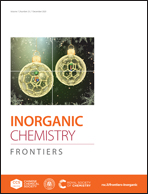Tuning magnetic anisotropy by the π-bonding features of the axial ligands and the electronic effects of gold(i) atoms in 2D {Co(L)2[Au(CN)2]2}n metal–organic frameworks with field-induced single-ion magnet behaviour†
Abstract
The assembly of a Co(II) salt with two [Au(CN)2]− anions and ancillary ligands L afforded 2D complexes of the general formula {Co(L)2[Au(CN)2]2}n (where L = DMSO (1), DMF (2), Py (3) and PyPhCO (4); PyPhCO is benzoylpyridine). The structure of these complexes consists of parallel sheets, which are built from edge-sharing slightly distorted square-planar {NC–Au–CN–Co}4 units with the Co(II) ions located at the corners and the [Au(CN)2]− bridging anions at the edges. Co(II) atoms exhibit a slightly tetragonally distorted CoN4X2 coordination sphere (X = O, N), where the L molecules occupy the axial positions. These molecules are oriented in such a way that they penetrate the holes of neighbouring layers, giving rise in the case of 1, 2 and 4 to AB bilayers held together by Au⋯Au aurophilic interactions, whereas in 3, there are no aurophilic interactions between neighbouring layers, so they are not arranged in pairs but equally separated. Dc magnetic properties, HFEPR (high-frequency and -field EPR) and FIRMS (far-infrared magnetic spectroscopy) measurements and ab initio calculations demonstrate that Co(II) ions in compounds 1–4 possess large and positive D values (≳+70 cm−1). The experimental D values follow the same order as that established from ab initio calculations including gold(I) atoms: D (2) > D (4) > D (3) > D (1), which highlights the important role of Au(I) in determining the anisotropy of the Co(II) ions. All the complexes show field-induced slow relaxation of magnetization through a predominant Raman mechanism above 3 K. Neither the anisotropy order nor the Co(II)⋯Co(II) distances are clearly correlated with the phenomenological Ueff parameter (or the Raman parameters). This fact suggests that other factors, such as the flexibility of the axial ligands, could significantly contribute to the fast relaxation observed for these complexes.
![Graphical abstract: Tuning magnetic anisotropy by the π-bonding features of the axial ligands and the electronic effects of gold(i) atoms in 2D {Co(L)2[Au(CN)2]2}n metal–organic frameworks with field-induced single-ion magnet behaviour](/en/Image/Get?imageInfo.ImageType=GA&imageInfo.ImageIdentifier.ManuscriptID=D0QI00996B&imageInfo.ImageIdentifier.Year=2020)
- This article is part of the themed collection: Recent Open Access Articles in Frontiers Journals


 Please wait while we load your content...
Please wait while we load your content...